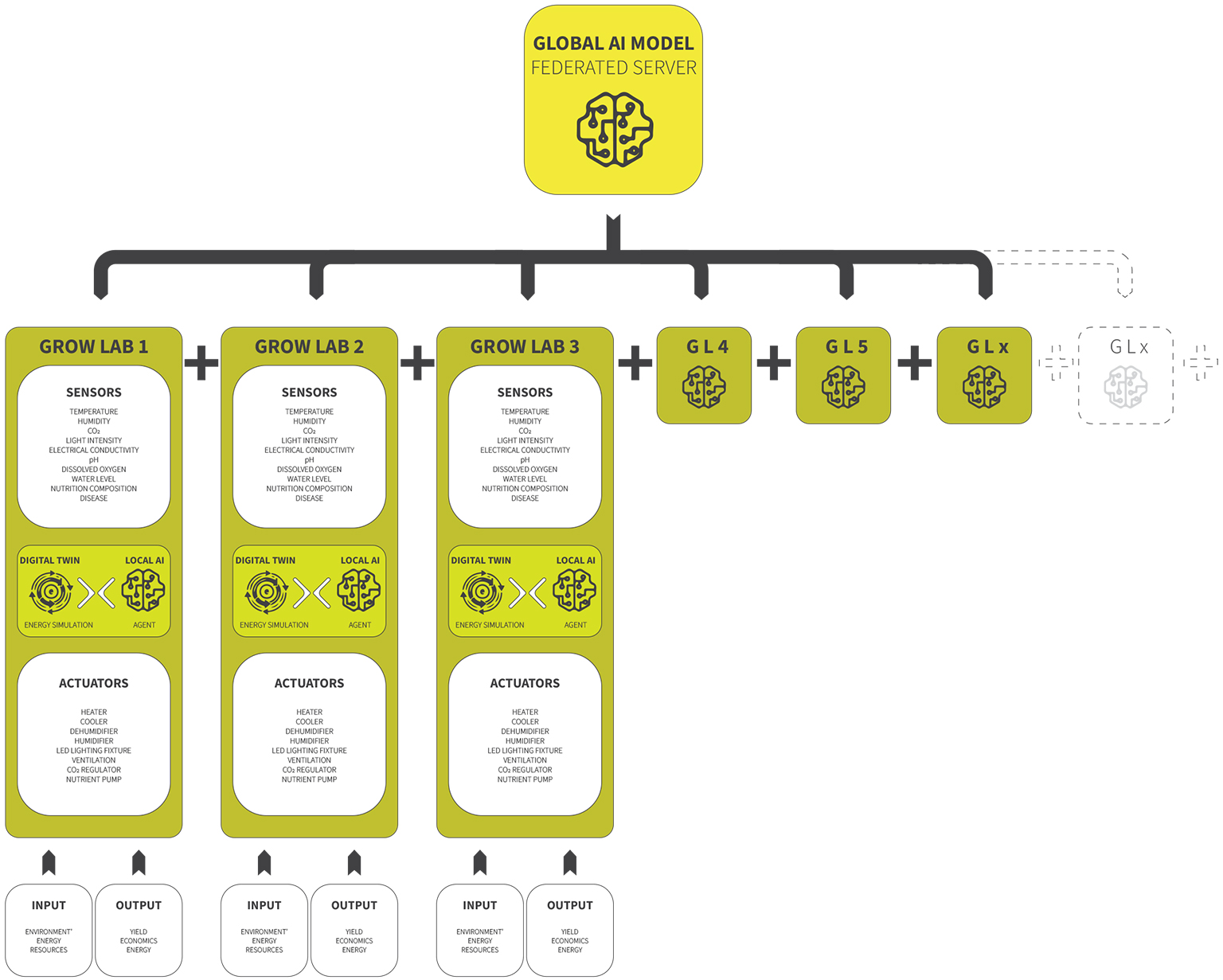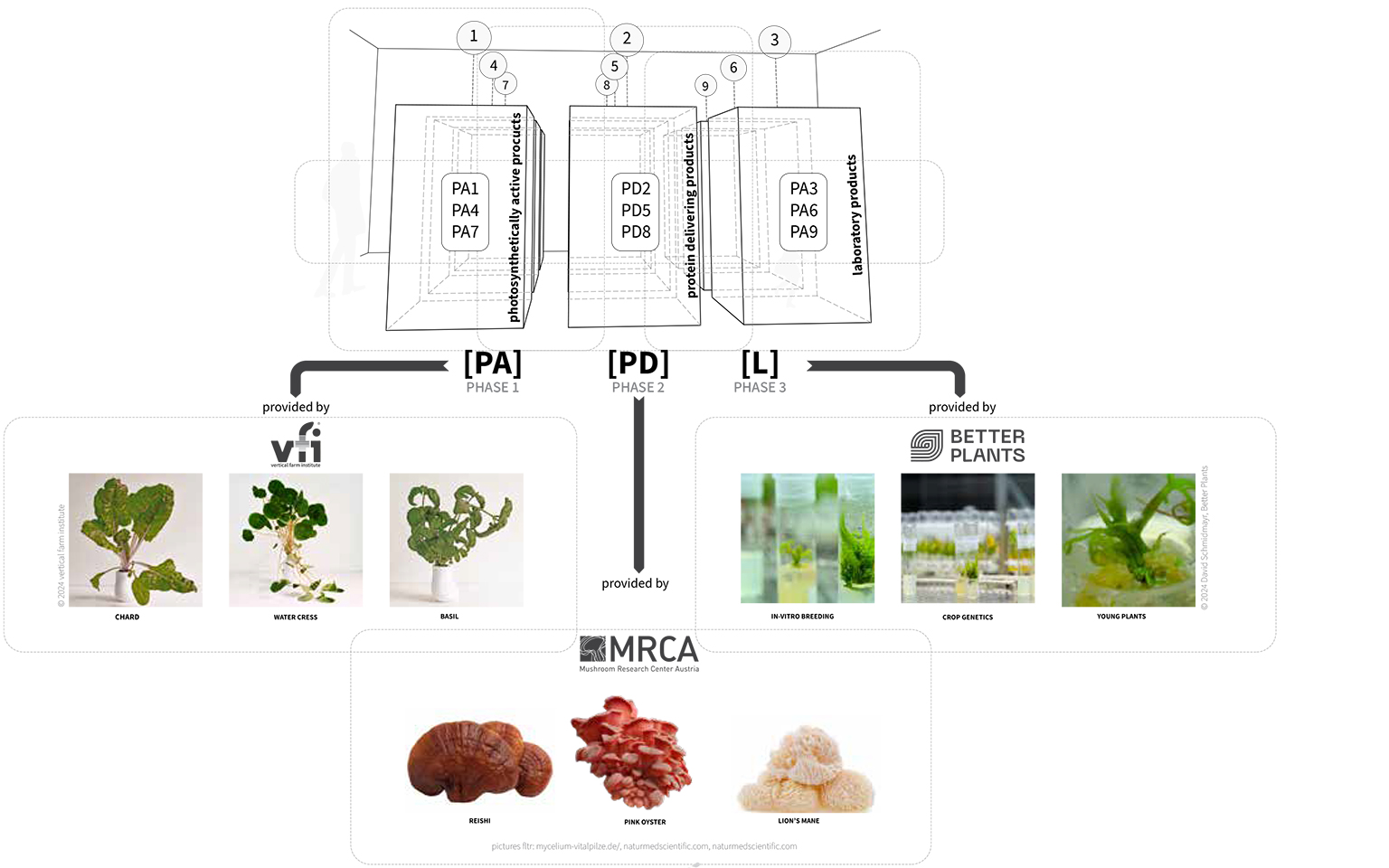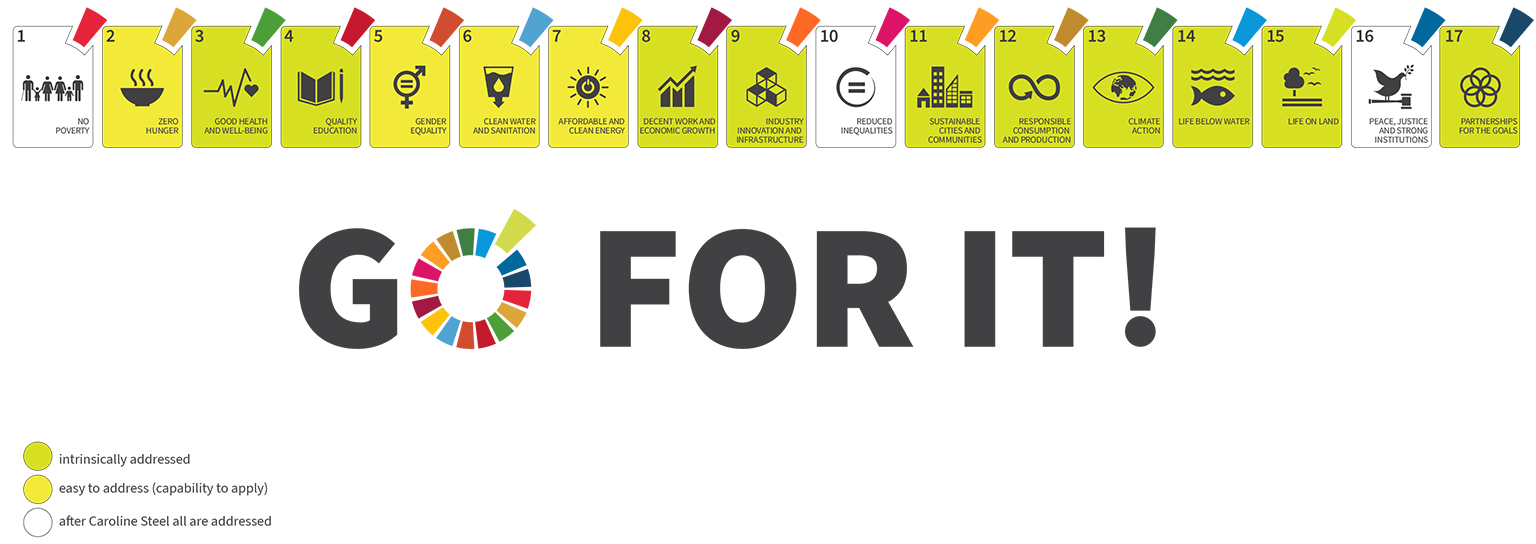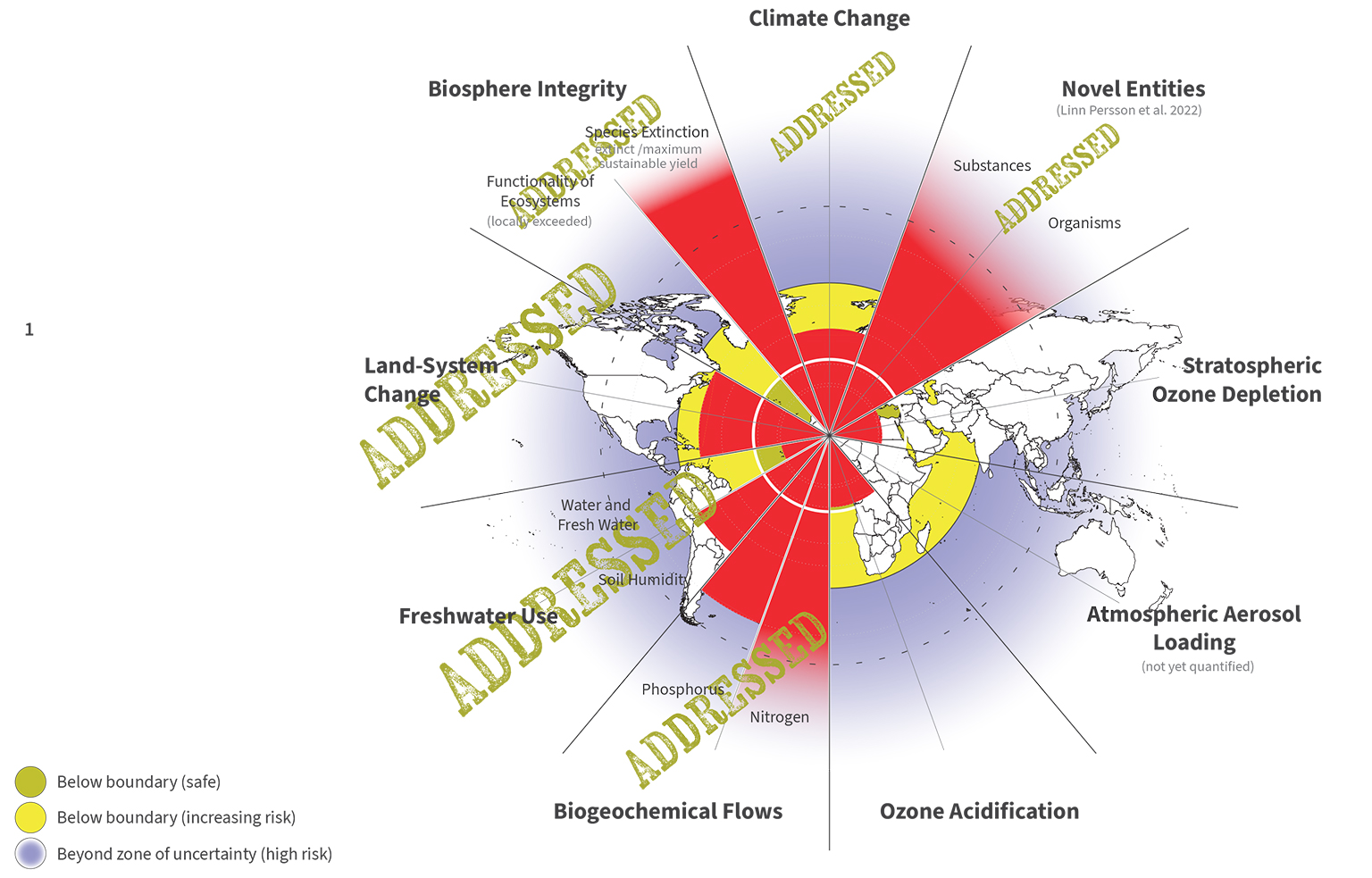Again, to begin with
Conceptual foundations for upcoming R&D-projects (e.g. UFA - Urban Food Agents)
Although it is no longer audible, we must continue to discuss it until observable changes occur. The radical reduction of land use[1] [2] in the understanding of produced energy content for human food supply per square meter is a simple to follow value. This is reached with optimum growth conditions which meet the ideal requirements pro specific produce and therefor the increase in yield or more crop rotations, the guaranteed annual production practice (which can’t be addressed by conventional farming) independent from climate zones and weather conditions[3] and the option to use stackable cultivation- and production methods. In addition, food gets produced on already sealed surfaces or additional food gets produced without changing natural land to productive land – in an impressive global scale through deforestation.
[1] Orsini, F. et. al.. sustainable use of resources in plant factorys with artificial lighting (PFALs), Eur. J. Hortic. Sci. 85(5), 297–309, p. 302
[2] Podmirseg, D. “up! Contribution of Vertical Farms to increase the overall Energy Efficiency of cities”, p. 321 ff.
[3] Annual damage balance for hail, draught and frost, Austria only

The Food and the City
As a theoretical model, set up by the vertical farm institute in 2019, the implementation of 11.000 buildings in the size of a 70 m-high rise building[1] would be enough to supply all citizens of Vienna[2] with needed kilocalories – in being autarchic. The conventional agricultural practice today leads to land use equivalent to the federate state of Burgenland. And by encountering the global hectares of today’s agricultural practices in addition the area of Lower Austria would be needed[3]. 11.000 buildings might sound a lot, but it only encounters 8% of the building stock[4] of the municipality.
This number doesn’t have to be understood as a proclaimed goal, because it would lead to numerous additional challenges which not only are related to a radical increase in energy demand[5]. But it highlights potentials related to area- or better space use efficiency potential of cities or metropolitan regions in general.
We must distinguish between the needed growth conditions of food produce (comparable to the level of comfort of building programs like residential, offices, industrial etc.). The required ideal temperature, relative humidity and photosynthetic active radiation, photon flux density and daylight integral differ strongly.
By neglecting that the power demand and therefor (dependent from the power mix of specific cities or regions) the CO₂-emissions per kJ (kilojoule) of food supply reach numbers which counteract the up-mentioned self-evident fundamental advantages, this leads to one of the primary reasons why some of front runner Startups failed within the past energy crisis.
[1] Equivalent to the volume of Uniqa Tower at Schedenplatz, Vienna
[2] 2023: 2.000.000 inhabitants
[3] FAO Food Balance Sheets / own calculations: 2.054 to of food supply of which 1.491 t (optimistic est.) directly get consumed.
[4] Courtesy of Magistratsabteilung 23 and Stadtbaudirektion
[5] For the reason that this number represents all vegetal and animal products of the FAO-listed food items and of course, if talking about new constructions, the amount of embodied energy for building materials.
Current debate
With this said we’re touching a principal misunderstanding or perhaps suppression of one of the central, essential components of the conception of built environments optimized for food production: the provision of energy to meet the ideal growth conditions.
This issue, though, is known from the very beginning of our research activity and should have been acknowledged and considered in business models or requested by investors. It goes back to the very early pioneers work of the first vertical farms, formerly defined as Phytotowers which emerged in the first sixties and got exported worldwide until the early 80ies.[1] In current debates mostly the discussion is referring to the power consumption by substituting sunlight with artificial lighting.[2] But this is valid just for one position of one production concept for one specific business model.
The solution to this problem in the discussion on indoor farming in general lies in a very simple, yet complex endeavor – the focus on the overall energy performance of functions- and space programs including all structural elements of the food system and subsequently in the integration of it in existing buildings[3] or new constructions within the urban environment. “The Vertical Farm is a building typology where its functions primarily focus on the urban food supply chain through controlled environment agriculture. The building is a structural element of the urban ecosystem.”[4] Only the systemic comparison of CEA-practices and conventional farming highlight potentials in addressing existing and upcoming sustainability goals.
The radical reduction in land use[5] has already been highlighted. Besides that, energy consumption might be the stumbling block in the implementation for two reasons:
- The obvious increase in power consumption by substituting all natural parameters, including sunlight for photosynthetic active products
- Misleading and embellished numbers communicated directly by Startups themselves which at the beginning create false expectations and lead to mistrust after evaluation activities.
[1] With the company Ruthner Industrieller Pflanzenbau we can say that Vertical Farming is an Austrian invention. After an abrupt end of the company’s expansion owed to the death of the inventor, the idea was forgotten due to a lack of publication and processing. Recently the vfi started with the setup of the archive and the documentation of min. 22 phytotowers constructed in Austria, Europe, USA, the Arabic world and Asia (ongoing project).
[2] For the simple reason because this energy position easily can represent 30% of the operative costs of plant factories producing photosynthetic active products such as lettuces, herbs or microgreens (Phase 1-products).
[3] Approx. 400 km² of unused indoor space exist in Austria only. Courtesy of Hagelversicherung and Umweltbundesamt. Also retrievable here.
[4] This definition is the basis of the discussion all around the contribution to reach sustainable development goals of urban local food production and supply and it radically distinguishes its intention and practice to plant factories, which in the vfi’s paradigm are falsely defined as vertical farms. The attached nomenklatura should help to clearly differentiate between practices, systems and types of urban farming.
[5] “The land area required for vegetable production is about one-hundredth that of open fields, and there is no damage by weather, pest insects, worms or wild animals.” Kozai, T.. Towards sustainable plant factories with artificial lighting (PFALs) for achieving SDGs, p. 35.

Open debate
In this context one must understand that we won’t save the world by producing lettuces.[1] But we can contribute our efforts in planning and research by expanding our practices to develop solutions for indoor food production which meet – on a differentiated level – requested growth conditions for more food items.
By classifying them into photosynthetically active, protein deliverers and produce in laboratory environments (PA, PD, L) we see, that the energy consumption for the production entity itself meets competitive and arguable values which in some cases are even lower than conventional functions such as offices or residential. A long list of mushrooms or insects, tropical fruits, cell-based meat and other products of cellular agriculture or biotechnological procedures are part of this category. A shortly concluded extensive feasibility study of a new building typology for a 100.000 m² urban development area in Berlin not only delivers absolute numbers in energy consumption (kWh/m²/a)[2] but also demonstrated the synergy potentials between the different conventional programs and vertical farming functions both energy and resource-wise.[3]
[1] Regardless the low energy performance / energy conversion of plant factories which can be criticized, the past decade made remarkable contributions on a scientific level all around growth conditions (lighting recipes, HVAC-considerations, air flow, nutrient recipes or other aspects of cultivation- and production methods
[2] (…) demonstrating the differences between PA, PD and L-products
[3] Results of recent feasibility studies for uban development areas

GSDG and Planetary Boundaries considered
Regardless of the failure of several Startups in the past decade for neglecting the energy issue, this business field contributed to a boost in knowledge-generation, industry- and infrastructure innovation. New sub-economic networks were established, process lines got shortened and optimized and remarkable steps forward have been tested and established in the field of IoT, automation and robotics. In concrete terms, this means that transportation networks have imploded. This ensures that the negative effects of the existing food supply chain are minimized. This approach is central to optimizing the discussion, as it inevitably leads to a reduction in CO₂ emissions through reduced oil consumption, among other things.[1]
Projects such as Vertical Harvest[2], founded in 2013 and built in 2015, also sustainably demonstrate the extent to which the direct, inclusive involvement of the population in production, processing and distribution has an impact on the responsible use of food. The production facility in Jackson, Wyoming, has become a “public hotspot”, a public space that has established a central sustainable community in the heart of the city. Mentally and physically challenged individuals are given assigned responsibilities in a dignified work environment. This facility is the demonstrator for much larger facilities currently under construction and design (Mayne and Detroit).
In particular, the facility in Portland, Mayne (which will open in November this year), is the result of the further development of the building and cultivation system. It follows the goals of most plants with a similar concept, which aims to close the water cycle as best as possible through intelligent control systems, thereby leading to a significant reduction in macronutrients such as phosphorus, potassium and nitrogen.
In addition to reducing land use and freshwater consumption[3], this also addresses a third major limit of our planetary system: the reduction of biogeochemical flows[4]. The latter also contribute to almost 10% of the primary energy requirements of the food sector, with phosphorus, for example, being extracted by large mining operations[5] [6].
UFA is establishing multiple Grow Labs, which conceptually in the long-term vision of the project consortium represent nine vertical farms. These labs aim to create and develop an AI-supported algorithm with advanced food-dedicated simulation processes. This algorithm will not only manage energy and resource streams between different building spaces but also optimize urban food production units through mutual federated learning. By considering weather forecasts, yield, quality, and cost predictions, the system will help achieve Global Sustainable Development Goals, account for cities’ energy and climate targets, and respect planetary boundaries.
[1] The author is not aware of any studies that have investigated the negative effects of the food value chain longer and more precisely than DEFRA.
[2] Vertical Harvest in Jackson, Wyoming
[3] “While several benefits are reported for CEA facilities compared to traditional agriculture including vastly reduced land by up to 300%, water use up to 95%, and pesticide requirement, a number of challenges remain for a wider deployment of CEA.” Engler, N., Krarti, M.. Review of energy efficiency in controlled environment agriculture, p. 9
[4] Planetary boundaries from 2009 – 2023, Stockholm Resilience Center
[5] SMIL, V. 2008. Energy in Nature and Society, Cambridge, Mass., MIT Press.
[6] Podmirseg, D. “up! Contribution of Vertical Farms to increase the overall Energy Efficiency of cities”, Diagram on p.87

Final considerations
Why do we talk about building typologies? Actual numbers on land use, dependencies on hydrocarbon energy, soil degradation for massive fertilizer use and changes in fertility for climate change effects draw a clear picture – for decades now – that world conventional agriculture is under a deep pressure to supply earthlings with food. 30% of the land mass is reserved for food production today, until 2075 an additional surface equivalent to Australia must be converted from natural land to productive land. On the other hand, this practice which slowly moves into a resilient system for food supply, could be disburdened from its pressure by critically reflecting to what extend energy in terms of kcal needed for humans could be directly produced next to them. Today’s food supply chain is a complex global network connected by energy consuming traffic, storage-, refrigeration- and processing elements which contribute to 30% of TPES and an equivalent percentage of CO₂eq on greenhouse gasses.
There is no need to say, that livestock production takes a big part in land use and emissions, but to wait for political decisions on a global scale to radically reduce its consumption is rather naïve and incompatible with daily real-politic pressures. That’s why the discussions on alternative proteins are exponentially growing within the last years, although already by the beginning of the 20th century T. Baron Russell (1905) predicted a future where plant-based foods would replace animal products due to economic and ethical reasons. In addition, today, what Russell couldn’t predict, additional challenges emerging with climate change.
Superimposed economy and ethics: By looking at the FAO’s FBS[1] and comparing data from the 50ies to today, proteins from soy, pea, lentils, nuts etc. got replaced by animal proteins in industrial countries. Emerging markets of lab-grown meat from animal cells, the production of Mycoproteins, (edible) Algae and a growing number of different types of insects are heading for substituting animal proteins with proteins which a remarkable reduction of the food footprint[2]. All these food items can be produced in within the city limit with a lower energy demand of most conventional programmes.
On a small-scale UFA will contribute to expand knowledge on this issue with Phase 2 and Phase 3-products[3] (PD and L – Grow Labs). On a bigger scale from the perspective of the author this societal challenge must be addressed respectively. This touches education, curricula of cross-fertilizing practices of academia and universities and the support of emerging vocational fields.
TPES worldwide is still rising and emissions of the food sector, too[4]. This fact should not be misled by hyperlocal or regional improvements. UFA aims for contributing to this discussion with a broader perspective by delivering information and visualization of actual energy- and resource flows, its interdependencies and synergy potentials by combining PA, PD and L-products in indoor environments in the heart of the city.